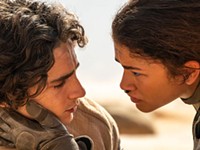[
{
"name": "500x250 Ad",
"insertPoint": "5",
"component": "15667920",
"parentWrapperClass": "",
"requiredCountToDisplay": "1"
}
]
Disney's choice to release Marvel's "Black Panther" during Black History month was both cynical and smart. The company identified an underserved film-going population and gave them a $200 million hero, exploiting the annual celebration of black excellence to pad the stats for its latest blockbuster -- the first black-directed Marvel adaption with a mostly black cast. Movies at this scale with powerful black faces in high places are rare. Disney's calculation was rewarded.
The response to "Black Panther," particularly by the black community, was exuberant. According to comScore, 37% of Black Panther's opening weekend moviegoers were black -- more than twice the 15% average for a typical blockbuster. In Rochester, two dozen people queued in the lobby 40 minutes before my 6:15 p.m. Saturday night show time. Local donors spent $2,400 on tickets for Rochester City School District students; similar instances of crowdsourcing tickets for black children were reported across the country -- all this in a seemingly spontaneous celebration of a film they had not seen. It was the representation of black culture that mattered to them, a message that I hope Hollywood understands. While the film does not match the scale of the meaning of this phenomenon, the attempt is worthy of applause.
Director Ryan Coogler ("Fruitvale Station," "Creed") elegantly establishes Wakanda, a fictional African kingdom untouched by European colonialism, where much of "Black Panther" is set. Wakanda is full of pristine lands and the greatest sunsets you'll ever see. It's also hermetically sealed by perceived poverty and advanced technology. This seal hides the powerful, unknown mineral Vibranium in plain sight. Vibranium can heal bullet wounds, power a nation, or destroy tanks. Vibranium can only be found in Wakanda.
This African paradise is protected by the spirit and power of the Black Panther -- a half Superman, half religious figure passed through generations. Wakandan kings reign as the Black Panther until they are unable. In this case, the recently assassinated King T'Chaka (John Kani) has passed it on to his son T'Challa (Chadwick Boseman).
T'Challa is handsome, good humored, soft spoken, and lovelorn after a split from his girlfriend Nakia (Lupita Nyong'o), who opted to go on missions across the world instead of staying by his side. His spunky little sister Shuri (Leticia Wright), is the lead technologist of Wakanda. Shuri is to T'Challa what Alfred is to Batman -- an advisor on personal matters, and creator of the latest vibranium-fueled tech, including the newest Black Panther suit. Unlike Alfred, Shuri is also a well-trained warrior.
As advanced as Wakanda is, at its core it's a nation ruled by male monarchs empowered by tribes with royal blood, relying on an ancient system of rule-by-combat. Before T'Challa can become King, he accepts a challenge from M'Baku (Brighton High School graduate Winston Duke) and emerges victorious. In that challenge lies the first hint at the film's moral crisis: How should Wakanda use vibranium? Wakanda's people are privileged and prosperous, yet the film importantly acknowledges that most of the African diaspora are not. An impressive, heavy theme for a blockbuster.
Three schools of thought on how to approach vibranium joust throughout the film: M'Baku's ape-themed tribe dismisses the technological advances by the royals as hedonistic. The ruling class's dogma is to preserve Wakanda for future generations while helping the world in small ways. Wakanda has spies across the world, and we see them -- Nakia included -- operating in the shadows, using fake accents, speaking foreign languages, and using their Wakandan powers to fend off evil-doers.
The final take is from the film's villain, Killmonger (Michael B. Jordan), a half-Wakandan African American whose body is covered in brands, one for each person he's killed. Killmonger uses one of the film's few white characters, a music obsessed, bionic gun-armed terrorist named Ulysses Klaue (Andy Serkis), and his band of white thugs as pawns in a plot to seize control of Wakanda. Once in power, he plans to recreate the British Empire with a black ruler, even using the colonial phrase: "The sun will never set on our empire."
Killmonger is an apt illustration of the film's uneven relationship with stereotypes. "Black Panther" strives to slay some stereotypes, while embracing others in troublesome, convenient ways -- the film justifies Killmonger's actions by using a few ham-fisted nods to American slavery. The only other adult character that lived among African Americans, N'Jobu (Sterling K. Brown), conspired to commit terrorism, and this could easily be read as reflective of the stereotype that American black males are inherently violent.
Another example of this is the fact that Nakia and Shuri are negated in the film's final act --both characters become strangely submissive as the future of their nation is threatened. They openly reject an opportunity to join the fight; instead they seek out a man from a rival tribe to fight for them. This puzzling decision is among the many compromises that prevent the film from reaching high art. But high art is a little much to ask from a Disney-produced, comic book adaption, isn't it? "Black Panther" is noisy and beautiful at a distance, but I cannot confuse exuberance for a cultural moment with excellence.












